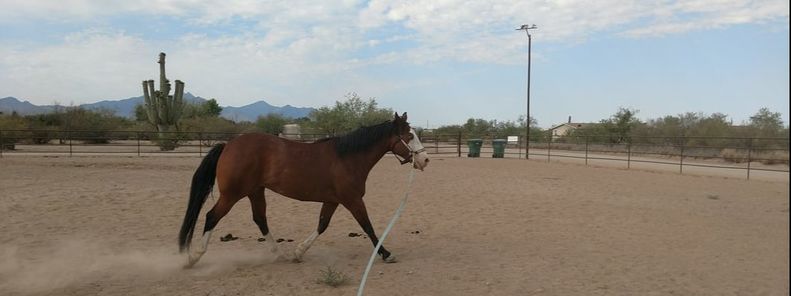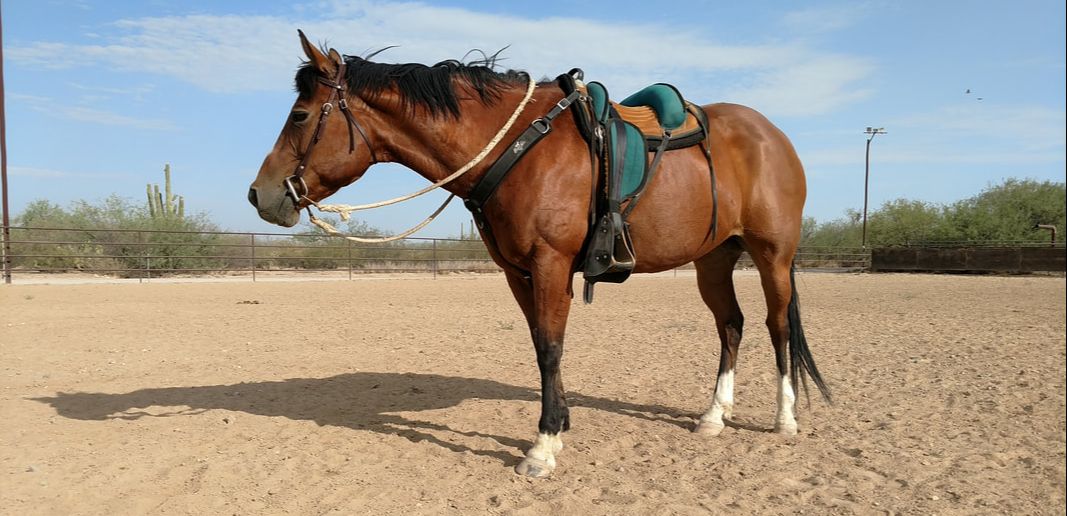|
This post may contain affiliate or sponsored links. Please read our Privacy Policy and Disclaimer. Why should you lunge your horse before you ride? Lunging takes time and requires extra equipment that you must haul down to the arena and put away later. For those on a time crunch, lunging may seem unnecessary, but this is an important first step for a successful training session.
Remember, horses are athletes and need to prepare physically and mentally for training, just like human athletes. Lunging gives your horse a chance to get into a “work” mindset and warm up his muscles. You have the chance to evaluate your horse’s attitude and your own mindset. With both of you physically and mentally ready to ride, you set your training session up for success.
Even though my horses are 11 and 18, I still take the time to lunge them before every ride. Both are well-broke enough to throw a saddle on and ride into the desert, but I have found that spending 15 to 20 minutes on the lunge line relaxes both of us and prepares us for work. The right equipment will help you get the most out of your lunging session. See exactly what you need in Improve Your Horse's Balance and Topline with the Right Lunging Equipment. I evaluate four points before every ride – the horse’s way of going, the horse’s attitude, tack fit, and my own mindset.
Way of Going
The first point I evaluate when I lunge is the horse’s way of going. My horse might have been sound the day before, but that does not guarantee that she is sound today. I have one who is especially accident prone, so I evaluate her closely to make sure she is sound. I do not want little soundness issues to turn into big issues. I start my lunging session by looking at the overall picture and then narrow down anything that seems “off.” To do this, I check the following points:
Attitude
The horse’s attitude is just as important as his way of going. A sound horse with a bad attitude is not fun to ride. I ride mares, and they are prone to bad attitude days, especially when they are in heat. A 20-minute lunging session gives them the chance to work out their bad attitude on the lunge line before we start our ride, and sometimes they are so off that I decide to skip a ride and try again the next day. (As a woman, I do understand that sometimes they do not feel their best, and I can work with that.) Lunging also gives your horse the chance to go from a “play” to a “work” mindset. This is especially important with young horses and stallions. This is what I check while evaluating my horse’s attitude:
Tack Fit
If I am going to ride, I always lunge my horse in the tack that I will use. This gives me the opportunity to evaluate how my tack fits my horse and notice any rubbing or pinching spots before the horse bucks due to discomfort. Proper tack fit is important to prevent long-term soundness issues. Horses are athletes and their bodies change over time. Tack that previously fit properly may not anymore, so I check my tack fit every time I ride. This is what I look for:
Your Attitude
The last point I evaluate when I lunge my horse is my own attitude. Honest self-evaluation is hard, but well worth it for a successful ride. I cannot expect my horse to perform well if I am not in the right mindset. My horse responds to my attitude, so I must get myself in the right mindset before I put my foot in the stirrup. A lunging session gives me a chance to evaluate myself and make any attitude adjustments before I ride. If I cannot change my attitude and I notice it negatively affecting my horse, sometimes I decide not to ride and give myself the time to fix what is bothering me. This is what I evaluate with my own attitude:
A Good Mindset for Horse and Rider The lists above seem like a lot to evaluate in a short lunging session, but really, these evaluations take very little time unless you need to narrow down a problem. You know your horse, so you will recognize if something is not quite right. After that, you can spend the remainder of your lunging session warming up your horse’s body and getting him into a work mindset. Taking the time to lunge your horse before every ride and doing a thorough evaluation sets you up for success. What do you evaluate when you lunge your horse? Let me know in the comments below!
5 Comments
Tammy Sherbet
7/17/2019 07:39:44 am
I just lunged my horse for the first time yesterday and I’m not sure but I think it gave me more exercise then my horse . Lol I really not sure what I doing it looks easier then it is .....any tips would be much appreciated . Thanks I enjoy ur articles
Reply
Alissa Berry
7/24/2019 07:53:01 pm
If your horse is new to the lunge line, start in a round pen or in a corner of the arena to help guide your horse in a circle. Make sure you stay in the magic triangle -- behind the shoulder but in front of the hip. It takes practice, for sure, but you will eventually find your rhythm.
Reply
Lacey
1/5/2020 01:13:15 pm
What do you mean magic 🔺?
Milo Goltz
7/9/2020 02:12:36 pm
Thanks MUCH Ma'am for your thoughts! I've been training and showing a seven yr. old Qtr mare for four years and have been really enjoying "the ride." Had to respond as I also have yet to just "hop on" and expect a bomb proof venture. When her head starts to level out and she has some character of being relaxed, then we start schooling or just hanging out together with me..."up." A couple of years ago, we were lunging before a show in tack, and she put on a bucking performance for a couple of circles that made a friend of mine ask me if anything more than "8 second events" was what I was there for LOL. We later had another good day. Mercy.Cares, mg
Reply
I completely agree that lunging your horse is essential to prepare both physically and mentally for training. I particularly appreciate your emphasis on evaluating your horse's attitude, which is often overlooked. I've had my fair share of rides on <a href="https://centerlinedistribution.net">hot horse</a>s, and I can't stress enough how important it is to have a horse in the right mindset before mounting. It's interesting to note how a 20-minute lunging session can help a horse go from "play" to "work" mindset, which is particularly important for young horses and stallions. Thanks for sharing your insights and tips for evaluating your horse's way of going, attitude, tack fit, and your own mindset. It's a great reminder for all horse owners to take the time to properly prepare for a successful training session.
Reply
Leave a Reply. |
AuthorWelcome! I've been a freelance writer since 2002 and have numerous horse-related articles published in print and online publications. I have a Bachelor of Science degree from Rocky Mountain College with a major in Equestrian Studies and a minor in Business Management. My current business ventures include High Plains Arena and real estate investing. Archives
March 2019
Categories
All
|
Proudly powered by Weebly





 RSS Feed
RSS Feed